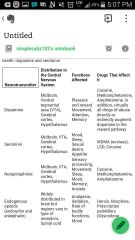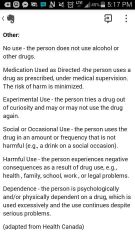![]()
![]()
![]()
Use LEFT and RIGHT arrow keys to navigate between flashcards;
Use UP and DOWN arrow keys to flip the card;
H to show hint;
A reads text to speech;
23 Cards in this Set
- Front
- Back
- 3rd side (hint)
|
Definition of concurrent disorders
|
someone who has a mental illness as well as a substance abuse problem
|
cocaine and depression, heroine and anxiety
|
|
|
how do substance use and mental health problems affect each other
|
create, trigger, worsen, mimic, mask
|
|
|
|
tolerance
|
a condition in which higher doses of a drug are required to produce the same effect experienced during initial use
often associated with physical dependance |
|
|
|
With drawal
|
With regular use of a substance, biochemical and structural adaptations take place in the brain
|
|
|
|
physical dependance
|
psychological state that occurs with regular drug use and results in a withdrawal syndrome is when drug use is stopped
|
|
|
|
depressants
|
Depressants – Produce a reduction of arousal and activity in the central nervous system. These drugs are used for therapeutically as anaesthetics, sedatives, anti anxiety agents and aids for sleeping.
|
|
|
|
opiods
|
Opioids – Or opiates are a specific subgroup of CNS depressants. The distinct attribute that differentiates these psychoactive agents from other CNS depressants is their ability to mask pain ands supress cough.
|
|
|
|
stimulants
|
Stimulants – Produce a general increase in the activity of the cerebral cortex, creating mood elevation, increased vigilance, and the postponement of fatigue. Some stimulants are also used as appetite suppressants, decongestants, and to treat attention deficit disorder with hyperactivity in children.
|
|
|
|
hallucinogens
|
Hallucinogens – Produce a generalized disruption in the brain, especially perception, cognition, and mood.
|
|
|
|
psychotherapeutic
|
psychotherapeutic Agents – Used to treat people with specific forms of mental illness: Depression, bipolar, and psychosis. They produce unpleasant side effects in people without the condition as well as in those with a mental health issue.
|
|
|
|
ways of using drugs
|

|
|
|
|
neurotransmitters
|
How brain cells communicate: the cells, neurotransmitter (s), receptor, and synapse. Common neurotransmitters impacting mental health: dopamine and serotonin
|
|
|
|
neurotransmitters
|

|
|
|
|
moral model
|
The Moral Model: Belief that using any drug is unacceptable, wrong and sinful.
Perceives dependence on a drug as a consequence of a weak moral character. This model offers no room for treatment and puts the responsibility and blame solely on the user. |
|
|
|
disease model
|
The Disease Model: In its purest form, the disease model contends that certain individuals have a distinct physical or psychological condition that renders them incapable of drinking or using drugs in moderation.
Believes that substance dependency is an involuntary biological trait to which certain people are susceptible, and thus drug users are not responsible for their compulsive drug addiction. |
|
|
|
biological theories
|
Biological Theories: Searches for a pre-existing or induced chemical, physiological, or structural abnormality as the cause of substance abuse.
|
|
|
|
precontemplation
|
Precontemplation Individuals in the precontemplation stage of change are not even thinking about changing their drinking behavior. They may not see it as a problem, or they think that others who point out the problem are exaggerating. |
|
|
|
contemplation
|
Contemplation
Individuals in this stage of change are willing to consider the possibility that they have a problem, and the possibility offers hope for change. However, people who are contemplating change are often highly ambivalent. They are on the fence. Contemplation is not a commitment, not a decision to change. People at this stage are often quite interested in learning about alcoholism and treatment. They know that drinking is causing problems, and they often have a mental list of all the reasons that drinking is bad for them. But even with all these negatives, they still cannot make a decision to change. |
|
|
|
determination
|
Determination: Commitment to Action
Deciding to stop drinking is the hallmark of this stage of change. All the weighing of pros and cons, all the risk-reward analysis, finally tips the balance in favor of change. Not all ambivalence has been resolved, but ambivalence no longer represents an insurmountable barrier to change. Most individuals in this stage will make a serious attempt to stop drinking in the near future. Individuals in this stage appear to be ready and committed to action. |
|
|
|
action
|
Action: Implementing the Plan
Individuals in this stage of change put their plan into action. This stage typically involves making some form of public commitment to stop drinking in order to get external confirmation of the plan. If they have not done so already, individuals in this stage may enter counseling or some form of outpatient treatment, start to attend AA meetings or tell their family members and friends about their decision—or all of the |
|
|
|
maintenance
|
Maintenance, Relapse and Recycling
The action stage normally takes three to six months to complete. Change requires building a new pattern of behavior over time. The real test of change is long-term sustained change over many years. This stage of successful change is called “maintenance.” In this stage, an alcohol-free life is becoming firmly established, and the threat of a return to old patterns becomes less intense and less frequent. |
|
|
|
termination
|
Termination
The ultimate goal in the change process is termination. At this stage, the alcoholic no longer finds that alcohol presents a temptation or threat; he has complete confidence that he can cope without fear of relapse. |
|
|
|
continuem of drug use
|

|
|

